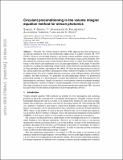Circulant preconditioning in the volume integral equation method for silicon photonics
Author(s)
Groth, Samuel P; Polimeridis, Athanasios G; Tambova, Alexandra; White, Jacob K
DownloadSubmitted version (1.292Mb)
Terms of use
Metadata
Show full item recordAbstract
© 2019 Optical Society of America Recently, the volume integral equation (VIE) approach has been proposed as an efficient simulation tool for silicon photonics applications [J. Lightw. Technol. 36, 3765 (2018)]. However, for the high-frequency and strong-contrast problems arising in photonics, the convergence of iterative solvers for the solution of the linear system can be extremely slow. The uniform discretization of the volume integral operator leads to a three-level Toeplitz matrix, which is well suited to preconditioning via its circulant approximation. In this paper, we describe an effective circulant preconditioning strategy based on the multilevel circulant preconditioner of Chan and Olkin [Numer. Algorithms 6, 89 (1994)]. We show that this approach proves ideal in the canonical photonics problem of propagation within a uniform waveguide, in which the flow is unidirectional. For more complex photonics structures, such as Bragg gratings, directional couplers, and disk resonators, we generalize our preconditioning strategy via geometrical partitioning (leading to a block-diagonal circulant preconditioner) and homogenization (for inhomogeneous structures). Finally, we introduce a novel memory reduction technique enabling the preconditioner's memory footprint to remain manageable, even for extremely long structures. The range of numerical results we present demonstrates that the preconditioned VIE is fast and has great utility for the numerical exploration of prototype photonics devices.
Date issued
2019Department
Massachusetts Institute of Technology. Department of Electrical Engineering and Computer ScienceJournal
Journal of the Optical Society of America A: Optics and Image Science, and Vision
Publisher
The Optical Society